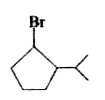Which of the following pentahalides is not formed ?
NF5
PF5
AsF5
BiF5
The correct Answer is:A
To solve the question "Which of the following pentahalides is not formed?" we will analyze the given options and the electronic configurations of the elements involved.
1. Identify the Elements and Their Pentahalides:
- The options provided are:
1. NF5
2. PF5
3. AsF5
4. BiF5
2. Understand the Concept of Pentahalides:
- Pentahalides are compounds formed when an element bonds with five halogen atoms. For an element to form a pentahalide, it must have the ability to expand its valence shell to accommodate five bonding pairs.
3. Analyze Nitrogen (N) for NF5:
- Nitrogen has an atomic number of 7 and an electronic configuration of 1s² 2s² 2p³.
- It has three electrons in its outer shell (2s and 2p orbitals) and can form a maximum of three covalent bonds (as seen in compounds like NH3 and NF3).
- Importantly, nitrogen does not have vacant d-orbitals to accommodate additional bonds beyond three.
4. Analyze Phosphorus (P) for PF5:
- Phosphorus has an atomic number of 15 and an electronic configuration of 1s² 2s² 2p⁶ 3s² 3p³.
- It can expand its valence shell and has vacant d-orbitals, allowing it to form PF5.
5. Analyze Arsenic (As) for AsF5:
- Arsenic has an atomic number of 33 and an electronic configuration of 1s² 2s² 2p⁶ 3s² 3p⁶ 3d¹⁰ 4s² 4p³.
- Similar to phosphorus, arsenic can also expand its valence shell and has vacant d-orbitals, allowing it to form AsF5.
6. Analyze Bismuth (Bi) for BiF5:
- Bismuth has an atomic number of 83 and an electronic configuration of 1s² 2s² 2p⁶ 3s² 3p⁶ 3d¹⁰ 4s² 4p⁶ 4d¹⁰ 5s² 5p³.
- Bismuth can also expand its valence shell and has vacant d-orbitals, allowing it to form BiF5.
7. Conclusion:
- Among the options, NF5 cannot be formed because nitrogen lacks the necessary vacant d-orbitals to accommodate five bonds. Therefore, the correct answer is NF5.
Final Answer:
NF5 is the pentahalide that is not formed.
- The options provided are:
1. NF5
2. PF5
3. AsF5
4. BiF5
- Pentahalides are compounds formed when an element bonds with five halogen atoms. For an element to form a pentahalide, it must have the ability to expand its valence shell to accommodate five bonding pairs.
- Nitrogen has an atomic number of 7 and an electronic configuration of 1s² 2s² 2p³.
- It has three electrons in its outer shell (2s and 2p orbitals) and can form a maximum of three covalent bonds (as seen in compounds like NH3 and NF3).
- Importantly, nitrogen does not have vacant d-orbitals to accommodate additional bonds beyond three.
- Phosphorus has an atomic number of 15 and an electronic configuration of 1s² 2s² 2p⁶ 3s² 3p³.
- It can expand its valence shell and has vacant d-orbitals, allowing it to form PF5.
- Arsenic has an atomic number of 33 and an electronic configuration of 1s² 2s² 2p⁶ 3s² 3p⁶ 3d¹⁰ 4s² 4p³.
- Similar to phosphorus, arsenic can also expand its valence shell and has vacant d-orbitals, allowing it to form AsF5.
- Bismuth has an atomic number of 83 and an electronic configuration of 1s² 2s² 2p⁶ 3s² 3p⁶ 3d¹⁰ 4s² 4p⁶ 4d¹⁰ 5s² 5p³.
- Bismuth can also expand its valence shell and has vacant d-orbitals, allowing it to form BiF5.
- Among the options, NF5 cannot be formed because nitrogen lacks the necessary vacant d-orbitals to accommodate five bonds. Therefore, the correct answer is NF5.
NF5 is the pentahalide that is not formed.
Similar Questions
Knowledge Check
Which of the following products is not formed in following reaction?
 A
A B
B C
C D
D

which of the following products is not formed in above reaction : products are
View SolutionWhich of the following oxide does not form dimer?
View SolutionWhich of the following form alkynide ?
View SolutionWhich of the following pairs will not form a buffer solution?
View SolutionWhich of the following reaction will not form racemic mixture as product?
View SolutionWhich of the following reaction will not form racemic mixture as product?
View SolutionWhich of the following compound are meso forms?

View Solution
